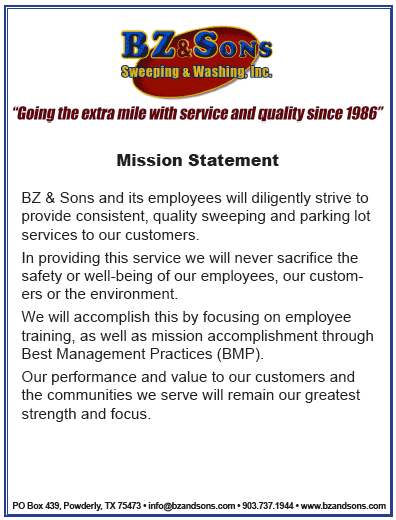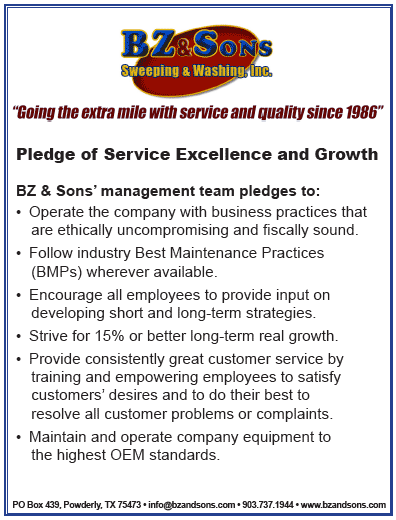Management Tools for Parking Area Sweeping |
Developing and Documenting Your Company's Philosophy
by Ranger Kidwell-Ross
There is much value in developing and documenting the 'philosophy' of your company. In addition to providing a goal to attain, doing so can empower employees and provide guidelines for their behavior.I recently assisted client Bob Stumpf, Jr., whose sweeping company was our Contractor of the Month for January 2010, with two 'belief statements' for his company, BZ & Sons, Inc. When I asked if I might share the result of his efforts with the sweeping community at large, his immediate answer provided the character of the man: "Yes, absolutely. I wouldn't be where I am today if it weren't for all the people who said 'Yes' when I asked them to help me out." Stumpf had never set his company mission down on paper for all to see, and he found it a process of revelation. "I knew, in general terms, what I wanted to say," says Stumpf. "Getting it down just right, though, was an interesting process." In the end, Stumpf came up with two separate statements that have become the guiding principles for his firm. Let's start with his Mission Statement. Please read what he came up with prior to continuing. Developing a Mission Statement
Many contractors – perhaps most – have never bothered with a Mission Statement. Some simply don't know how or think they couldn't do it 'right.' Others may not see the value in having such a document as part of their company. First off, there is no 'right.' A Mission Statement will vary for each company. However, when posted on the wall for employees to read and re-read; when used in training; when utilized in your marketing and as a goal to attain, Mission Statements have enormous value. When you analyze the BZ & Sons Mission Statement, you will see it is a series of 'what' and 'how' sentences. In this instance, Stumpf led off with his intent for his company and its employees, to "provide consistent, quality sweeping and parking lot services to our customers." That opening 'what' clause is followed by three 'how' clauses. The first of these covers the topic of integrity, "...we will never sacrifice the safety or well-being... The second 'how' sentence covers the methods that Stumpf expects to have used to reach the company's stated goals, i.e., via training and utilization of Best Management Practices. The final sentence in Stumpf's Mission Statement is a summation of what the previous three clauses, when followed, can bring to the company. It also focuses the strength of the company toward the service and value it can provide to its customers. Although many companies develop a Mission Statement and leave it at that, Stumpf felt there would be additional value to having a similar document that would be more of a day-to-day blueprint for company operations. Where the Mission Statement is more of an over-arching document of company goals, Stumpf's Pledge of Service Excellence and Growth offers six bullet points of how he wants the company to operate. Statement of Service Excellence and Growth
If one views the Mission Statement as an 'overall road map' for reaching the company's goal, the bullet points of the Statement of Service Excellence and Growth would then be the 'driving directions' for reaching the desired destination. As you see, Stumpf leads right out with two clauses that speak to the ethics he wants in his company. In addition to providing directions for his employees, they are also standards he will need to adhere to in his own management decisions. You can bet his employees will be watching. Ultimately, their behavior in regard to ethics and BMPs will only be as good as the lead set by Stumpf and his management team. Stumpf's next clause is one of empowerment to his employees. His inclusion is admirable, and likely to pay dividends as time goes by. Expressing his goal for growth, as he does in the next clause, will also be seen as a positive by his employees. Growth means room for advancement, as well as being part of a company that will be around in years to come. In the Statement's fifth clause, Stumpf again empowers his employees, this time to make decisions in favor of doing whatever it takes to keep customers satisfied. Long-time power sweeper manufacturer, Mark Schwarze, calls this process "wowing the customer." The clause makes it clear that employee decisionmaking will be supported if it errs on the side of satisfying the customer. The document's final clause speaks to the company's maintenance team, as well as to a commitment to the kind of vehicle maintenance it takes to provide the best service each time, every time.
I encourage you to think about how you have incorporated written standards and policies into your own company. Do you have a set of written guidelines to map your growth process as an organization? If so,
Ranger Kidwell-Ross is editor of WorldSweeper.com. If you have new information to provide on this topic, let him know and we can add it in as an addendum to this article. |
© 2005 - 2012
|
Parking Area Sweeping Contents
|